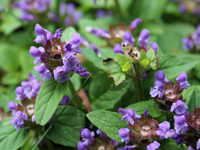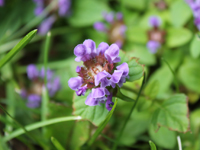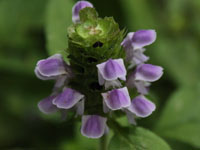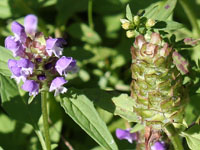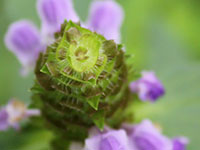![]()
Heal All is an herbaceous plant in the mint family which is native to Europe as well as certain parts of North America. Heal All is a perennial herb found throughout Europe, Asia and North America, as well as most temperate climates. Its origin seems to be European, though it has been documented in other countries since before any history of travel. The genus name Prunella is possibly derived from the latin prunum which means 'purple', a reference to the flower colour, or from the German bruen, 'quinsy' a throat disorder that was treated using this plant. The species name vulgaris means 'common'. The common name heal all pertains to the medicinal value of this plant.
![]()
Heal All is used a salad green in many cultures and studies are underway to use heal all in medical research. In vitro studies have shown heal all to have an antibacterial action, inhibiting the growth of pseudomonas, Bacillus typhi, E. coli, Mycobacterium tuberculi. It is also showing promise in research for AIDS as well as combating allergies.
![]() Within the realm of naturopathic medicine and folklore, heal all is taken internally as a medicinal tea for sore throat, fever, diarrhea, internal bleeding, and to alleviate liver and heart maladies. Topically, a poultice of the plant is applied to irritated skin, as from stinging nettle toxins. A poultice of heal all also serves well as a disinfecting agent and is used to pack wounds in the absence of other wound-care material. Heal All was considered by the Chinese to "change the course of a chronic disease". In traditional Austrian medicine, prunella vulgaris herb has been used internally as tea for treatment of disorders of the respiratory tract and infections.
Within the realm of naturopathic medicine and folklore, heal all is taken internally as a medicinal tea for sore throat, fever, diarrhea, internal bleeding, and to alleviate liver and heart maladies. Topically, a poultice of the plant is applied to irritated skin, as from stinging nettle toxins. A poultice of heal all also serves well as a disinfecting agent and is used to pack wounds in the absence of other wound-care material. Heal All was considered by the Chinese to "change the course of a chronic disease". In traditional Austrian medicine, prunella vulgaris herb has been used internally as tea for treatment of disorders of the respiratory tract and infections.
Please note that MIROFOSS does not suggest in any way that plants should be used in place of proper medical and psychological care. This information is provided here as a reference only.
![]()
Heal All is edible; the young leaves and stems can be eaten raw in salads; the whole plant can be boiled and eaten as a potherb; and the aerial parts of the plant can be powdered and brewed in a cold infusion to make a beverage. The Cherokee cooked and ate the young leaves. The Nlaka'pamux drank a cold infusion of the whole plant as a common beverage. The plant contains vitamins A, C, and K, as well as flavonoids and rutin.
Please note that MIROFOSS can not take any responsibility for any adverse effects from the consumption of plant species which are found in the wild. This information is provided here as a reference only.
![]()
Heal All is often found growing in moist areas, waste ground, grassland, woodland edges, and usually in basic and neutral soils. Heal All prefer to live in either full or partial sun and does not thrive in shade. Heal All can survive in areas with maritime exposure.
| Soil Conditions | |
| Soil Moisture | |
| Sunlight | |
| Notes: |
![]()
Heal All grows 5cm to 30cm high with creeping, self-rooting, reddish coloured stems that branch at the leaf axis. The stems are tough and square shaped like many plant species in the mint family. The leaves of the heal all plant are lance shaped, serrated, and reddish at the tip, approximately 2.5cm long and 1.5cm broad. The leaves grow in opposite pairs down the square stem of the plant. Each leaf has 3 to 7 veins that shoot off of from the middle vein to the margin. The stalks of the leaves are generally short, but can be up to 5cm long. The flowers of the heal all plant grow from a clublike, somewhat square, whirled cluster at the top of a stem. Immediately below this club, are a pair of stalkless leaves standing out on either side like a collar. Flowers are two lipped and tubular. The top lip is a blushish purple hood, and the bottom lip is often white; it has three lobes with the middle lobe being larger and fringed upwardly. Heal All propagates both by seed and vegetatively by creeping stems that root at the nodes.
![]()
| Plant Height | 15cm to 30cm | 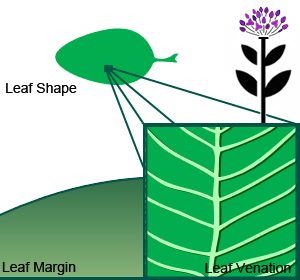 |
| Habitat | Roadsides, Fields, Gardens, Light forested areas | |
| Leaves | Ovate 2.5cm long | |
| Leaf Margin | Entire | |
| Leaf Venation | Pinnately lobed | |
| Stems | creeping stems up to 50cm long | |
| Flowering Season | July to September | |
| Flower Type | Rounded clusters of 15mm to 20mm flowers growing from a collar like base | |
| Flower Colour | violet-blue | |
| Pollination | Insect and Wind | |
| Flower Gender | Flowers are hermaphrodite and the plants are self-fertile | |
| Fruit | Small round seeds | |
| USDA Zone | 4A (-31.7°C to 34.4°C) cold weather limit |
![]()
There are currently no noted hazards when handling or choosing a location to plant heal all.
![]()
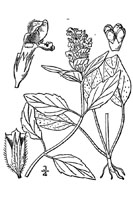 |
-Click here- or on the thumbnail image to see an artist rendering, from The United States Department of Agriculture, of creeping charlie. (This image will open in a new browser tab) |
![]()
 |
-Click here- or on the thumbnail image to see a magnified view, from The United States Department of Agriculture, of the seeds created by heal all for propagation. (This image will open in a new browser tab) |
![]()
Heal All can be referenced in certain current and historical texts under the following three names:
Heal All can be translated into the following select languages:
| Arabic | اشفاء جميع | Bulgarian | Излекувай All | Chinese (Sim) | 全部愈合 |
| Croatian | liječi sve | Czech | Léčit vše | Danish | Heal Alle |
| Dutch | Esperanto | sanigu Ĉiuj | Estonian | Heal Kõik | |
| Finnish | Heal Kaikki | French | guérir toutes | German | heilt Alle |
| Greek | Heal Όλα | Hebrew | לרפא כל | Hungarian | |
| Italian | Heal Tutti | Japanese | すべてのヒール | Korean | 모든 치유 |
| Low Saxon | Lithuanian | Heal Viskas | Norwegian | helbrede Alle | |
| Persian | دزخم التیام یابد همه | Polish | Heal wszystko | Portuguese | |
| Romanian | Heal Toate | Russian | врачевать всякую | Slovak | liečiť všetko |
| Spanish | Heal Todos | Swedish | Heal Alla | Tagalog | pagalingin ang lahat ng |
| Turkish | Tümünü Heal | Ukrainian | лікувати всяку | Vietnamese | chữa lành tất cả |

![]()
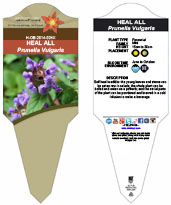 |
The MIROFOSS database offers free printable garden tags for personal and non-profit use. These tags can be used to properly identify plant samples in a garden. Click on the tags shown on the the screen or -click here- to download a full size jpeg image for a heal all identification tag; which can be printed on paper or used with a plastic laser printer. |
 |
What's this? What can I do with it? |
![]()
| Description | Uva, R.H., J.C. Neal,and J.M. DiTomaso. 1997. Weeds of the Northeast. Cornell University Press. Ithaca, New York. |
| Description | Clapham, A.R., Tutin, T.G. and Warburg, E.F. 1968. Excursion Flora of the British Isles. Cambridge University Press. ISBN 0-521-04656-4 |
| Biology | Stubbendieck, J., G.Y. Friisoe,and M.R. Bolick. 1994. Weeds of Nebraska and the Great Plains. Nebraska Department of Agriculture, Bureau of Plant Industry. Lincoln, Nebraska. |
| Biology | Kartesz, J.T. 1994. A synonymized checklist of the vascular flora of the United States, Canada, and Greenland. 2nd edition. 2 vols. Timber Press, Portland, OR. |
| Folklore | Foster, Steven; Hobbs, Christopher (2002). "Self-heal, Heal-All". A Field Guide to Western Medicinal Plants and Herbs. Houghton Mifflin Harcourt. p. 231. ISBN 978-0-395-83806-8 |
| Biology | Dickinson, T.; Metsger, D.; Bull, J.; & Dickinson, R. (2004) ROM Field Guide to Wildflowers of Ontario, Royal Ontario Museum, Toronto:McClelland and Stewart Ltd. |
| Environment | National Audubon Society. Field Guide To Wildflowers (Eastern Region): Alfred A. Knopf. ISBN 0-375-40232-2 |
| Physical Identification | National Audubon Society. Field Guide To Wildflowers (Eastern Region): Alfred A. Knopf. ISBN 0-375-40232-2 |
| March 01, 2015 | The last time this page was updated |
| ©2025 MIROFOSS™ Foundation | |
 |
|

